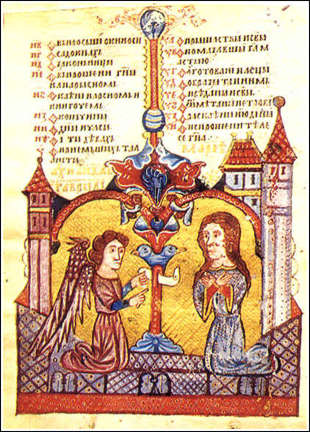Serbian Medieval History
Tvrtko I (1353 - 1391)
Assumes title King Stefan in 1391
The relative strength and coherence that Bosnia had achieved under ban Stjepan II Kotromanic (1314 - 1353) at first did not survive him. The following two decades of the rule of his teenage nephew and successor, Tvrtko I, were marked by typical strong hostility from wayward feudal lords and an emboldened Hungarian neighbor. The previous benevolence of the Hungarian king Lajosz (Louis) gave way to political pressures, including papal threats against the "heretic" Bosnian Church. As a result, Tvrtko had to accept considerable territorial losses and Hungarian overlordship in 1357. Over the next decade, his dealings with powerful northern suzerain were of mixed nature - they included a 1363 attack by two Lajosz' armies, which the ban managed to repulse, and a 1366-7 revolt of Bosnian feudal lords under Tvrtko's brother Vuk that saw the ban flee to Lajosz for safety - only to return victorious the following year. By the early 1370s, his reign restored and relatively stabilized, Tvrtko turned his eyes eastward, where the disintegration of the Serbian empire was unfolding.
![]() DOCTRINARY EVIDENCE, an illumination from Hval's Gospel
DOCTRINARY EVIDENCE, an illumination from Hval's Gospel
The first and major step in this involvement was his alliance with prince Lazar and their joint ousting of the hitherto powerful but haughty magnate Nikola Altomanovic. His defeat provided territorial gains to both allies, and as a result, the ban came into possession of some more centrally located Serbian lands, including part of the original Ras heartland and the famed Mileseva monastery that housed the relics of St. Sava. Combining this with his indisputable Nemanjic lineage, Tvrtko attempted a Serbian institutional revival under his auspices and had the Metropolitan of Mileseva crown him "King Stefan of Serbia and Bosnia", in a solemn ceremony in 1377. Thereafter, all Bosnian rulers bore that title, which drew its legitimacy directly from the Nemanjic tradition, and Tvrtko actively attempted to revive both court ceremonies and more substantive elements of that legacy alike. This move was unopposed by the remaining Serbian feudal lords - most importantly, prince Lazar - but had limited practical effect, as no central government institutions were to be restored on a broader level under Tvrtko. But the appeal of this idea was to remain, just as did the reputation of St. Sava's miracle-working relics among pilgrims of all faiths. Specifically, by further example, this is evidenced by the later attempt of the powerful splinter Bosnian nobleman, Stefan Vukcic Kosaca, to take in 1449 the arbitrary, but appealing title "Herceg (Duke) of Saint Sava", and whence that whole area (formerly Hum) was to be known as Hercegovina.
But Tvrtko's main contribution to a potential Serbian revival was the dutiful participation of his troops, under-celebrated commander Vlatko Vukovic, at the side of his ally prince Lazar, at the Battle of Kosovo. Tvrtko's correspondence with Western capitals shortly after the battle - based on his surviving troops' reports and claiming victory - are among the earliest surviving documents of the event.
The king's final years were marked by dealings with Dubrovnik and his attempts to acquire a major Adriatic Sea outlet; it is he who began building to that effect the city of Novi (later, Herceg-Novi) at the mouth of the Gulf of Kotor.
Tvrtko's premature death in 1391 marked an end to the more important fruits of his remarkable statesmanship. Bosnia did not disintegrate this time as it did following his father's death, but it remained a land of weak kings and powerful nobility, bound merely by shifting - at best - common interests. Mainly, the institutional scaffolding that could have prevented that was not there, including the important lack of a state-church alliance that could have developed a shared spiritual space and consciousness for most subjects. As a result, the collective memory of the Bosnian state did not survive the medieval feudal timeframe. To his credit - and in possible contrast to the Nemanjic state's attempt at southeastward expansion into well-established Greek-speaking realms - Tvrtko focused his efforts on an ethnolinguistically more compact South Slavic area. But to his detriment, neither he nor his successors (nor brethren further east) were able to command the allegiance of their subjects to an extent necessary to cohesively face the invading menace that was soon to engulf all of the Balkans.

An illumination from Hval's Gospel - one of the most famous of the scarce texts that survived from the Bosnian Church, issued in 1404, relatively shortly after Tvrtko's death. The scene depicts Archangel Gabriel and the Virgin Mary in the New Testament scene of Annunciation and is among other strong evidence that contradicts the standard assumption that the Bosnian Church was of the Bogomil doctrinal nature, given that the latter heresy denied any importance to either of these figures.
Others
More Information
BLAGO Content
While the content of the BLAGO Fund collections is free to use, there are also some restrictions on commercial use and proper attribution of the material. Follow the links below for more information.
> BLAGO Collections License
> Image Request
BLAGO Fund also accepts the contribution of material. Please contact us with any material you wish to publish on our website.
Contact
BLAGO Fund, Inc.
PO Box 60524
Palo Alto, CA 94306
USA
info@blagofund.org

